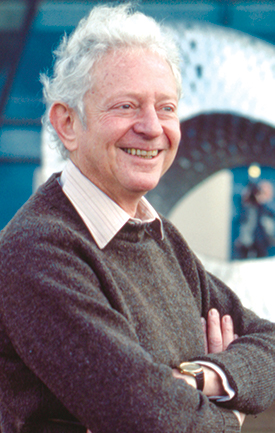Leon Max Lederman
DOI: 10.1063/PT.3.4118
A giant among particle physicists, Leon Max Lederman died on 3 October 2018 at a nursing home in Rexburg, Idaho, having suffered from dementia for several years.

Leon Max Lederman
FERMILAB

As an experimentalist, he was a trailblazer from early in his career. The experiments on which he worked were among the first to exploit advances in electronic counter methods. He was constantly on the cutting edge—he called it the “bleeding edge”—of discovery.
Lederman was instrumental in the invention and study of neutrino beams, which led to the 1962 discovery of the muon neutrino. His decade-long pursuit of lepton production in hadron collisions resulted in the 1977 discovery of the bottom quark. Other seminal breakthroughs in which he had a leading role include the observation of parity violation in the weak interactions and the discovery of the long-lived neutral kaon.
Born on 15 July 1922 in New York City, Lederman received his undergraduate degree in chemistry from the City College of New York in 1943. After spending three years in the Army Signal Corps, he began graduate studies at Columbia University, where the physics department was constructing a 380 MeV synchrocyclotron at its Nevis Laboratories. Lederman joined the project in 1948 and worked with Eugene Booth, the project’s director. As part of his doctoral work, Lederman built a Wilson cloud chamber, receiving his PhD in 1951. He then taught physics at Columbia; he became a professor in 1958 and Eugene Higgins Professor in 1972.
While at Columbia, Lederman was influential in the 1967 founding of Fermilab in Batavia, Illinois, near Chicago. He pushed for the laboratory to be truly national in nature. After the resignation of its founding director, Robert Wilson, Lederman left his Columbia faculty position and Nevis directorship to become Fermilab’s second director in 1979. During his tenure he transformed the lab from a “bare bones” operation to a facility that gave experimenters the tools and environment they needed to thrive. Those environmental changes included opening an after-hours restaurant at the Users Center and bringing the top chef from CERN to advise on improving the cafeteria.
Lederman was a founding member of the federal government’s High Energy Physics Advisory Panel in 1967 and the International Committee on Future Accelerators in 1977. While Fermilab director, he oversaw the construction of the Tevatron, the first superconducting accelerator and the most powerful of its day, capable of producing proton beams of 1 trillion eV and of colliding protons and antiprotons at energies up to 2 trillion eV, which led to the discovery of the top quark. Probing deeper into the structure of matter would require even more firepower; accordingly, throughout the 1980s Lederman was an energetic advocate for government funding for the Superconducting Super Collider, which was approved to be built in Texas. That dream was dashed when Congress canceled the project in 1993.
Toward the end of his tenure as Fermilab director, Lederman shared the 1988 Nobel Prize in Physics with Melvin Schwartz and Jack Steinberger for the discovery of the muon neutrino. Among his other honors, Lederman received the National Medal of Science in 1965, the Wolf Prize in Physics in 1982, and the Vannevar Bush Award in 2012.
After 10 years at the helm, Lederman turned over the reins of Fermilab and took a faculty position at the University of Chicago. In 1992, having reached the mandatory retirement age there, he moved to the Illinois Institute of Technology (IIT), where he chose to teach freshman physics. He retired in 2011.
Among Lederman’s most notable and successful outreach efforts were his initiatives for improving science education and popularizing science. He had a deep interest in teaching physics to nonexperts, from pre-med and humanities students at universities to the general public. At Fermilab, Lederman started the Saturday Morning Physics program, which attracts some 300 high school physics students each year for weekly lectures and tours. He also helped found the Illinois Mathematics and Science Academy for promising Illinois students and the Lederman Science Education Center, which brings thousands of grade school students to Fermilab each year for hands-on physics demonstrations and serves as a resource for area science teachers.
Recognizing that he could reach more students by working through teachers, Lederman founded the Illinois Research Corridor science and math summer program. He also founded and chaired the Teachers Academy for Mathematics and Science, designed to retrain 20 000 teachers in the Chicago Public Schools in the art of teaching science and mathematics. Lederman pushed for Physics First, a reversal of the standard high school biology-chemistry-physics pedagogical sequence, which he viewed as outdated. He and Ray Burnstein at IIT collaborated on ways to make lectures more engaging, which led to an interactive, wireless, RF-keypad approach, now in widespread use.
Lederman was probably best known to the general public for coining the term “God particle” for the elusive Higgs boson. It became the title of his popular 1993 book (with coauthor Dick Teresi), The God Particle: If the Universe Is the Answer, What Is the Question?
Lederman had a wonderful leadership style. He encouraged and valued contributions from everyone, whether senior scientist or beginning student. He had a subtle way of steering people in productive directions without dictating what they should do, and he was a master at using humor to make his points.
More about the Authors
Jeffrey A. Appel. West Chicago, Illinois.
Daniel Kaplan. Illinois Institute of Technology, Chicago.
